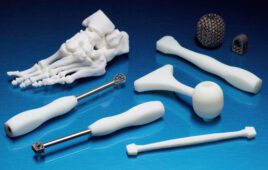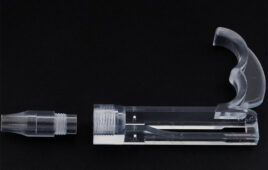“There’s a way to do it better. Find it.” — Thomas Edison
Medtech manufacturing professionals incessantly strive to find ways, as Edison encouraged, to do things better. Here are a few manufacturing trends to keep an eye on in the New Year. Some aren’t entirely new (though they continue to evolve), while others are just beginning and may be truly transformative.

(Photo by Joshua Sortino on Unsplash)
Andrew Potter, Bonifacio Consulting Services
Many deeply intertwined variables affect the business side of the medical device contract manufacturing sector: global markets and currency fluctuations; shifting clinical needs and varied patient populations; insurance, reimbursement and payment policy; raw material pricing and sourcing; manufacturing costs and margins. Those are just an important few. But what about manufacturing processes and technologies?
Automation and the Internet of Things (IoT)
Robotics, machine learning and artificial intelligence are reshaping automation, allowing companies to improve quality, maximize value, keep costs down or offer new services. As automation costs continue to drop and robots become more flexible and able to take on more tasks, justifying automation for lower-volume and lower-margin projects becomes easier.
Automation and the Internet of Things (IoT) overlap somewhat. Companies may gather operational data and analyze and leverage valuable information from manufacturing processes to change their organization and product development. Advanced analytics help to identify patterns and prerequisites for workflows and processes, such as preventative maintenance.
Automated manufacturing execution systems (MES) automate data collection into existing manufacturing resource planning/enterprise resource planning (ERP) structures. An MES can track and document the transformation of raw materials to finished goods, providing information that can help improve plant conditions to improve output.
Many companies use ERP software systems such as IQMS that show the status of all molding machines including uptime/downtime/cavity utilization, etc. Sensors and data collection will continue to expand into more areas of the plant and enable better decision-making based on real-time data, which can give a full picture into manufacturing processes, employee efficiency, and production planning effectiveness.
IoT can also help to maintain quality. Sensors can monitor humidity, ambient temperatures, water and other elements that could harm the quality of parts.
Companies need to ensure they are collecting relevant, accurate and useable information. Information should not be collected simply for the sake of collection.
Additive manufacturing
Medtech manufacturers have been quick to embrace additive manufacturing (AM), also known as 3D printing, for prototyping, tooling, and in limited cases, final production. Factors such as speed, secondary processing, and appropriate materials still curb massive adoption. Despite current limitations, benefits include:
• Time to market: Improved and rapid prototyping make it easier to test concepts, designs, usability, etc.
• Manufacturing efficiency: Customized and manufactured fixtures, jigs and mold inserts easily improve manufacturing operations.
• Improved designs: 3-D printing enables designs and components not possible with conventional manufacturing methods.
• Customized products: Surgical tools, implants, and other 3D-printed components could improve patients’ lives and make healthcare professionals’ work easier.
• Cost reduction: Costs should come down as components are manufactured as needed, and there should be fewer complications as the one-size-fits-all approach disappears.
Most of the initial excitement around medical additive manufacturing has focused on metal products such as implants. On the plastics side, much of the energy is still on 3-D printing for educational purposes and prototyping of customized anatomical body parts such as the heart. But plastics also are being used for customized surgical tools, braces and continuous positive airway pressure (or CPAP) masks used to treat sleep apnea. Ceramics are also being used to replace/strengthen bones, particularly in dental applications.
3-D bioprinting is an exciting and potentially life-changing technology in which biological materials are printed and then grown in “bioreactors” to create artificial tissues and organs. This is an emerging technology and not something that we expect to see in any large-scale manufacturing environments in the near term—but the potential is impressive. Additive manufacturing can also be used in the pharmaceutical sector to customize pills to individual patients’ time-release needs.
As in most new innovations in healthcare, it will take time before significant amounts of medical products manufactured by additive manufacturing will be realized. Regulations, training, confirmation of costs and efficacy, as well as the conservative nature of healthcare, all contribute to slow adoption.
People: The most important tech
Medtech manufacturers need to know how to find and recruit a new generation of talent for highly technical areas as well as for the shop floor. While they’ve begun to seek out people already working in the industry, recruiting to less urban settings has proven difficult with millennials and younger workers.
Many manufacturers who work with community and technical colleges to provide hands-on opportunities with good future prospects, and may help reverse public impressions of dirty, low-paying jobs on the verge of being sent offshore. Medtech manufacturing workers are more likely to specialize in research and development, engineering, automation, quality, and operational excellence.
U.S. manufacturing apprenticeships are making somewhat of a comeback, particularly in tooling, maintenance, and processing on the shop floor, automation, and quality. The number of American apprentices increased from 375,000 in 2014 to 500,000 in 2016. The federal government predicts 750,000 by the end of this year, helped in part by expanding the apprenticeship model to include white-collar occupations such as information technology.
Andrew Potter is managing director of Bonifacio Consulting Services.
The opinions expressed in this blog post are the author’s only and do not necessarily reflect those of Medical Design and Outsourcing or its employees.




